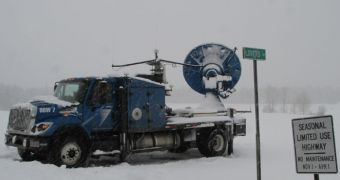Over the past few weeks, the East Coast of the United States and neighboring states have been buried under several feet of snow, brought in by severe snowstorms. Now, experts are gearing up to establish why these weather events are so intense, and they already have a potential culprit in mind.
According to investigators, the center of snowfall this year is the town of Oswego, New York, and the Tug Hill Plateau, located nearby. This is where the Doppler-on-Wheels (DOW) data-collecting radar dish will be placed.
Throughout January and February, scientists inside the DOW will track down the largest snowstorms that will form in the vicinity of the Great Lakes. They suspect that the landscape features play in important role in determining the intensity of the snowstorms.
The proximity of the lakes is what accelerates winds and snow to high gear, creating so-called lake-effect snowstorms. These atmospheric fronts develop parallel to the long axis of a Great Lake, scientists have determined.
Measurements an yearly statistics have demonstrated that the long lake-axis-parallel (LLAP) bands of snow produce among the largest amounts of snow in the world, at some of the highest rates.
But State University of New York (SUNY)-Oswego atmospheric scientists Scott Steiger and Alfred Stam, together with colleague Jeffrey Frame from the University of Illinois at Urbana-Champaign (UIUC) will face the storms this year, in a bid to learn precisely what produces the effect.
“The mobility of a DOW is ideal for following lake-effect storms. The DOW will allow us to witness them as they form and cross lakes, which other weather radars can't do,” Steiger explains.
The team will operate three such instruments, which are classified as atmospheric science facilities belonging to the US National Science Foundation (NSF).
A DOW is made up of a very large radio dish mounted on the back of a flatbed truck. Generators and other equipment make up the rest of the instrument. Despite their unsightly appearance, these machines are exactly what's needed to conduct such studies.
Because they use the Doppler effect, these radars are especially suited for determining the inner workings of even the most severe storms, explains the director of the Center for Severe Weather Research (CSWR) in Boulder, Colorado, Josh Wurman.
“NSF's dual-polarization DOW radars offer an important new avenue toward better understanding this intense winter weather phenomenon affecting the Great Lakes region,” explains Brad Smull.
The official is the program director in the NSF Division of Atmospheric and Geospace Sciences. The DAGS provides funding for both the DOW and the LLAP project.

 14 DAY TRIAL //
14 DAY TRIAL //